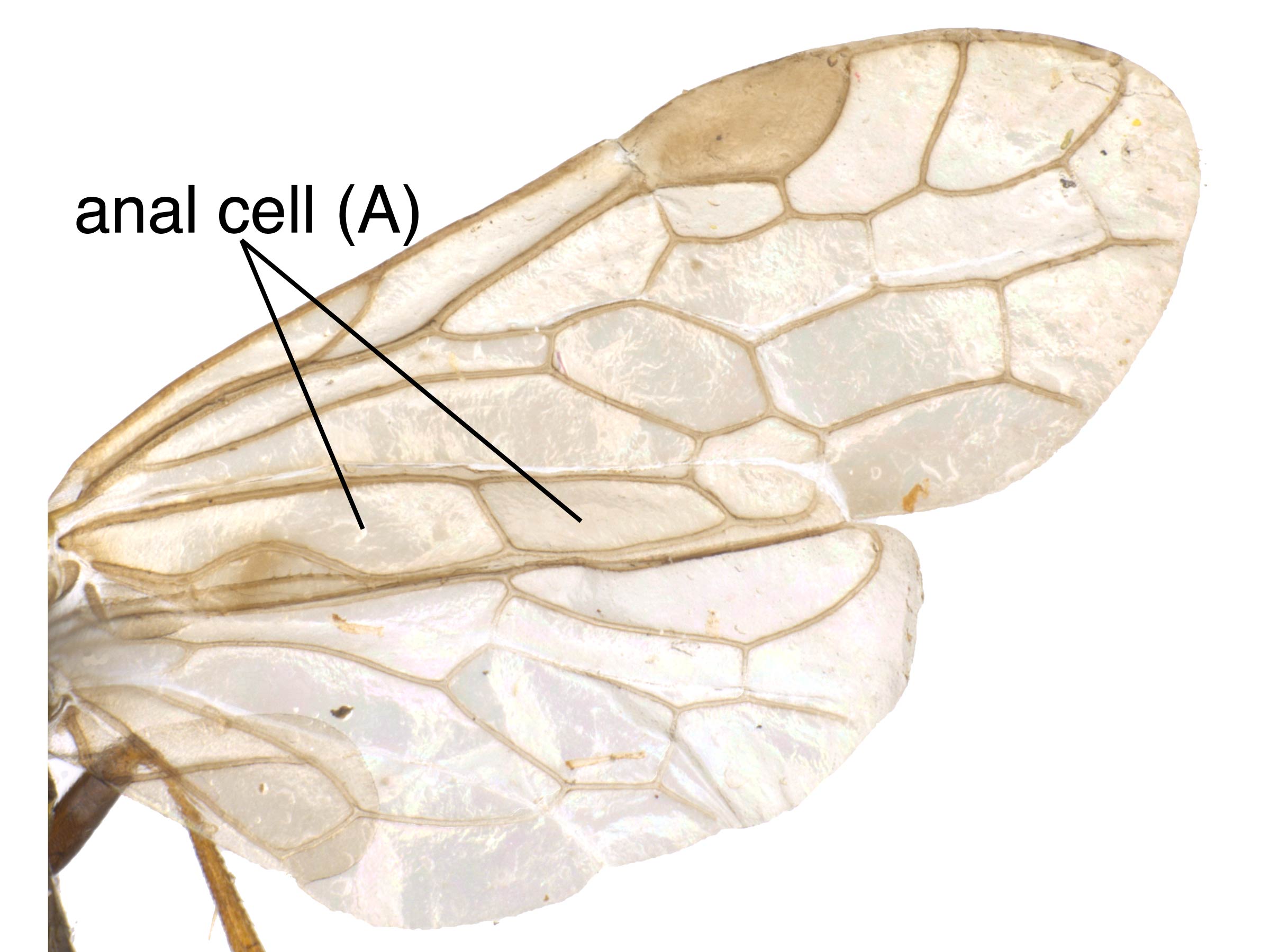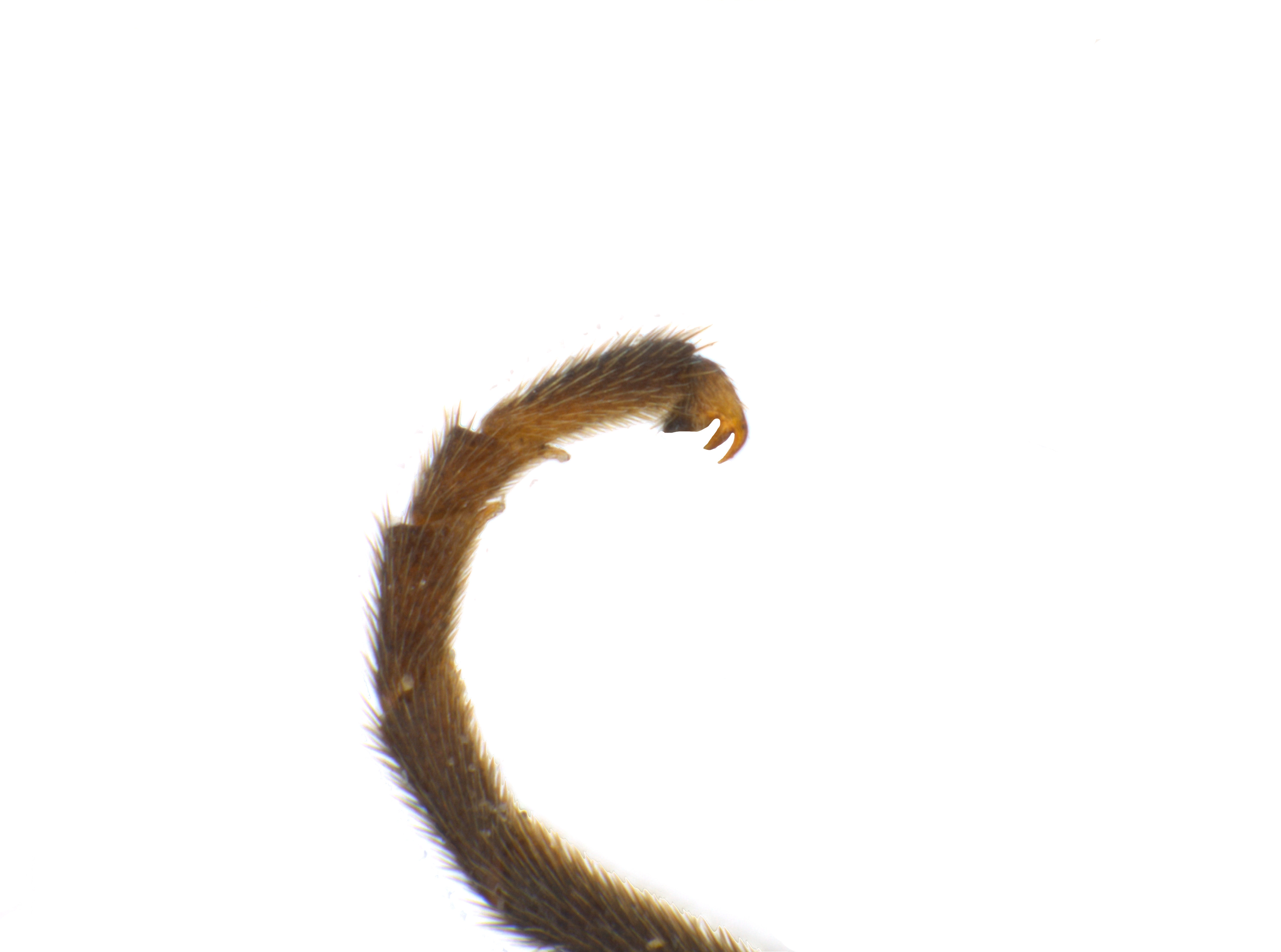Family: Tenthredinidae
Family common name: common sawflies
Subfamily: Heterarthrinae
Tribe: Fenusini
Genus: Bidigitus D.R. Smith, 1967
Subgenera: none
The Tenthredinidae are the most species-rich family and are found throughout the world, in all continents but Antarctica. They are known as the “common sawflies.” They can generally be recognized by a cylindrical body and long, segmented antennaeantenna:
the sensory organ emerging from the front of the head, usually between the compound eyes and above the clypeus; includes the flagellum, scape and pedicel
 . Otherwise, they come in a variety of colors, sizes, and forms (Goulet 1992Goulet 1992:
. Otherwise, they come in a variety of colors, sizes, and forms (Goulet 1992Goulet 1992:
Goulet H. 1992. The genera and subgenera of the sawflies of Canada and Alaska: Hymenoptera. Symphyta. The insects and arachnids of Canada. Part 20. Agriculture Canada Publication.).
Sawflies in the Heterarthrinae subfamily are generally small and dark-colored. Many species of this family are economic pests of trees and shrubs and can be characterized by their skeletonizing or leaf-mining larval feeding behaviors. Heterarthrinae adults can be distinguished from those of other subfamilies by wing venationvenation:
the network of veins on a wing
(Smith 1971aSmith 1971a:
Smith DR. 1971a. Nearctic Sawflies. III. Heterarthrinae: Adults and larvae (Hymenoptera: Tenthredinidae). Technical Bulletin, U.S. Department of Agriculture 1420: 1-84.).
Bidigitus is monotypicmonotypic:
describes having only one representative; ex. a genus that includes only one species
. Bidigitus platani has a very small recorded range and is fairly uncommon. The adults are small, about 4 mm, and mostly black with white markings on the legs (Smith 1971aSmith 1971a:
Smith DR. 1971a. Nearctic Sawflies. III. Heterarthrinae: Adults and larvae (Hymenoptera: Tenthredinidae). Technical Bulletin, U.S. Department of Agriculture 1420: 1-84.).
There is a single described species, and it is North American (Taeger et al. 2018Taeger et al. 2018:
Taeger A, Liston AD, Prous M, Groll EK, Gehroldt T, and Blank SM. 2018. ECatSymmdash;Electronic World Catalog of Symphyta (Insecta, Hymenoptera). Program version 5.0 (19 Dec 2018), data version 40 (23 Sep 2018). Senckenberg Deutsches Entomologisches Institut (SDEI), Muuml;ncheberg. https://sdei.de/ecatsym/ Accessed: 28 Jan 2020.).
Subfamily characters
 M slightly constricted at apexapex:
M slightly constricted at apexapex: vein 2r present (Goulet 1992Goulet 1992:
vein 2r present (Goulet 1992Goulet 1992:Genus characters
 veins 2A and 3A incomplete and curved upwards at apexapex:
veins 2A and 3A incomplete and curved upwards at apexapex: anal cellanal cell:
anal cellanal cell: present (Smith 1971aSmith 1971a:
present (Smith 1971aSmith 1971a: anal petiolepetiole:
anal petiolepetiole: (Smith 1971aSmith 1971a:
(Smith 1971aSmith 1971a: cells Rs and M both absent (Smith 1971aSmith 1971a:
cells Rs and M both absent (Smith 1971aSmith 1971a: bifidbifid:
bifidbifid: ; teeth of claw about equal in length (Smith 1971aSmith 1971a:
; teeth of claw about equal in length (Smith 1971aSmith 1971a: with large basalbasal:
with large basalbasal:Bidigitus can be confused with other genera in the subfamily, especially the similar genus Profenusa. It can be distinguished by the bifidbifid:
divided or forked into two branches or parts
 tarsal claw and the hind winghind wing:
tarsal claw and the hind winghind wing:
the posterior wing of each pair of wings
 anal cellanal cell:
anal cellanal cell:
cell A of either the fore wing or hind wing
 length to petiolepetiole:
length to petiolepetiole:
stalk or stem; used to describe basal vein stalk in wing OR basal stalk of a leaf.
length ratio (Smith 1967cSmith 1967c:
Smith DR. 1967c. A review of the subfamily Heterarthrinae in North America (Hymenoptera: Tenthredinidae). Proceedings of the Entomological Society of Washington 69: 277-284., Smith 1971aSmith 1971a:
Smith DR. 1971a. Nearctic Sawflies. III. Heterarthrinae: Adults and larvae (Hymenoptera: Tenthredinidae). Technical Bulletin, U.S. Department of Agriculture 1420: 1-84.).
none
Bidigitus platani feeds on Platanus racemosa (California plane tree) (Smith 1971aSmith 1971a:
Smith DR. 1971a. Nearctic Sawflies. III. Heterarthrinae: Adults and larvae (Hymenoptera: Tenthredinidae). Technical Bulletin, U.S. Department of Agriculture 1420: 1-84.).
Females oviposit into the upper side of leaves in early spring. The hatched larvaelarva:
the immature stage of holometabolous insects
 feed gregariously inside the leaf on the parenchymaparenchyma:
feed gregariously inside the leaf on the parenchymaparenchyma:
in plants, the soft, thin-walled, inner tissue that performs functions such as photosynthesis, storage, and secretion; as opposed to dermal and vascular tissues
as leaf miners, creating blotch mines. The feeding stage lasts about 30 days, and when the larvaelarva:
the immature stage of holometabolous insects
 are mature, they fall to the ground and build cocoons in which to pupate, or they overwinter and then pupate. Because of this quick life cycle, this species is multivoltinemultivoltine:
are mature, they fall to the ground and build cocoons in which to pupate, or they overwinter and then pupate. Because of this quick life cycle, this species is multivoltinemultivoltine:
describing a life cycle with many generations per calendar year
with 3–5 generations in a single year (Smith 1971aSmith 1971a:
Smith DR. 1971a. Nearctic Sawflies. III. Heterarthrinae: Adults and larvae (Hymenoptera: Tenthredinidae). Technical Bulletin, U.S. Department of Agriculture 1420: 1-84.).
World: This genus is North American (Taeger et al. 2018Taeger et al. 2018:
Taeger A, Liston AD, Prous M, Groll EK, Gehroldt T, and Blank SM. 2018. ECatSymmdash;Electronic World Catalog of Symphyta (Insecta, Hymenoptera). Program version 5.0 (19 Dec 2018), data version 40 (23 Sep 2018). Senckenberg Deutsches Entomologisches Institut (SDEI), Muuml;ncheberg. https://sdei.de/ecatsym/ Accessed: 28 Jan 2020.).
North America: Bidigitus occurs in California, specifically the southern region of the state, with records in Santa Barbara and Anaheim (Smith 1971aSmith 1971a:
Smith DR. 1971a. Nearctic Sawflies. III. Heterarthrinae: Adults and larvae (Hymenoptera: Tenthredinidae). Technical Bulletin, U.S. Department of Agriculture 1420: 1-84.).
Map data from the Smithsonian National Museum of Natural History Entomology Collection (USNM)
Details about data used for maps can be found here.